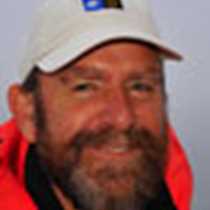Kapp Lee, Edgeøya 78º05’ N, 20º48’ E
Hope springs eternal as we wake this morning...but at 0500, up on the bridge wing, we are faced yet again with the Great Wall of Fog, Svalbard’s most famous feature. Our hearts sink: if this does not clear, it will rob us of the chance to go ashore. The fog does the dance of the seven veils, giving tantalizing glimpses of a hill, a dolerite cliff, some pieces of shipwrecked ice. 0530 and we put a scout boat down. Through a slot in The Wall we see the beach and a couple of reindeer: an easy landing. But by the time we are back onboard and have announced this plan, the fog has closed in yet again. 0800 we try anew, and with guns loaded and compass cocked, we approach the beach. Visibility down to 70 yards and the tide has now clogged the beach with ice. “Let’s check Kapp Lee,” says Stefan; we motor north, weaving through a chicane of ice floes. Suddenly, Tom stiffens “I smell walrus.” All naturalists on board are now very alert; mental monitors scroll through the litany of Inuit warnings: “At sea, never approach a walrus in a small boat...”
Five minutes later, two giant heads rise like dark rocks from the sea and sink again. Then, beyond a shadowy knoll, a grey beach of giant, pale boulders resolves itself into a sprawling haul-out of 120 walrus, tusks akimbo like bleached sabers. Just when all hope is gone, we have found a hidden haven for one of the strangest creatures in the Arctic: Hval-ros, the Horse-Whale. “Endeavour, Endeavour, we have walrus.” We hear Ralph’s swift reply over the hand-held radio: “Hallelujah!”
A swift council of war back at the ship and Captain Skog explains the conditions: “ Ship is 2 cables from land, fog down to 60 metres, tidal stream flooding north and drifting ice floes crossing our intended track. If we go in, we must travel in pairs, use GPS, compass and radar reflectors and radio back our situation every 10 minutes.” 10 heads nod, 10 orange float coats zipped up tight, 10 Zodiacs down.....We all make it through the fog, Zodiacs full of hushed passengers, and drift silently into the watery world of the walrus. Our Lindblad photographic tour group is ecstatic: land, sea and sky are all a perfect grey card, marred only by walrus bursting out of the water all round us. Two magical hours, drifting, watching and photographing. And the wide-eyed walrus sneeze, snort and harrumph back at us, bloodshot eyes rolling in equal astonishment. They will be talking about us for months; but we will remember them forever.
Hope springs eternal as we wake this morning...but at 0500, up on the bridge wing, we are faced yet again with the Great Wall of Fog, Svalbard’s most famous feature. Our hearts sink: if this does not clear, it will rob us of the chance to go ashore. The fog does the dance of the seven veils, giving tantalizing glimpses of a hill, a dolerite cliff, some pieces of shipwrecked ice. 0530 and we put a scout boat down. Through a slot in The Wall we see the beach and a couple of reindeer: an easy landing. But by the time we are back onboard and have announced this plan, the fog has closed in yet again. 0800 we try anew, and with guns loaded and compass cocked, we approach the beach. Visibility down to 70 yards and the tide has now clogged the beach with ice. “Let’s check Kapp Lee,” says Stefan; we motor north, weaving through a chicane of ice floes. Suddenly, Tom stiffens “I smell walrus.” All naturalists on board are now very alert; mental monitors scroll through the litany of Inuit warnings: “At sea, never approach a walrus in a small boat...”
Five minutes later, two giant heads rise like dark rocks from the sea and sink again. Then, beyond a shadowy knoll, a grey beach of giant, pale boulders resolves itself into a sprawling haul-out of 120 walrus, tusks akimbo like bleached sabers. Just when all hope is gone, we have found a hidden haven for one of the strangest creatures in the Arctic: Hval-ros, the Horse-Whale. “Endeavour, Endeavour, we have walrus.” We hear Ralph’s swift reply over the hand-held radio: “Hallelujah!”
A swift council of war back at the ship and Captain Skog explains the conditions: “ Ship is 2 cables from land, fog down to 60 metres, tidal stream flooding north and drifting ice floes crossing our intended track. If we go in, we must travel in pairs, use GPS, compass and radar reflectors and radio back our situation every 10 minutes.” 10 heads nod, 10 orange float coats zipped up tight, 10 Zodiacs down.....We all make it through the fog, Zodiacs full of hushed passengers, and drift silently into the watery world of the walrus. Our Lindblad photographic tour group is ecstatic: land, sea and sky are all a perfect grey card, marred only by walrus bursting out of the water all round us. Two magical hours, drifting, watching and photographing. And the wide-eyed walrus sneeze, snort and harrumph back at us, bloodshot eyes rolling in equal astonishment. They will be talking about us for months; but we will remember them forever.




